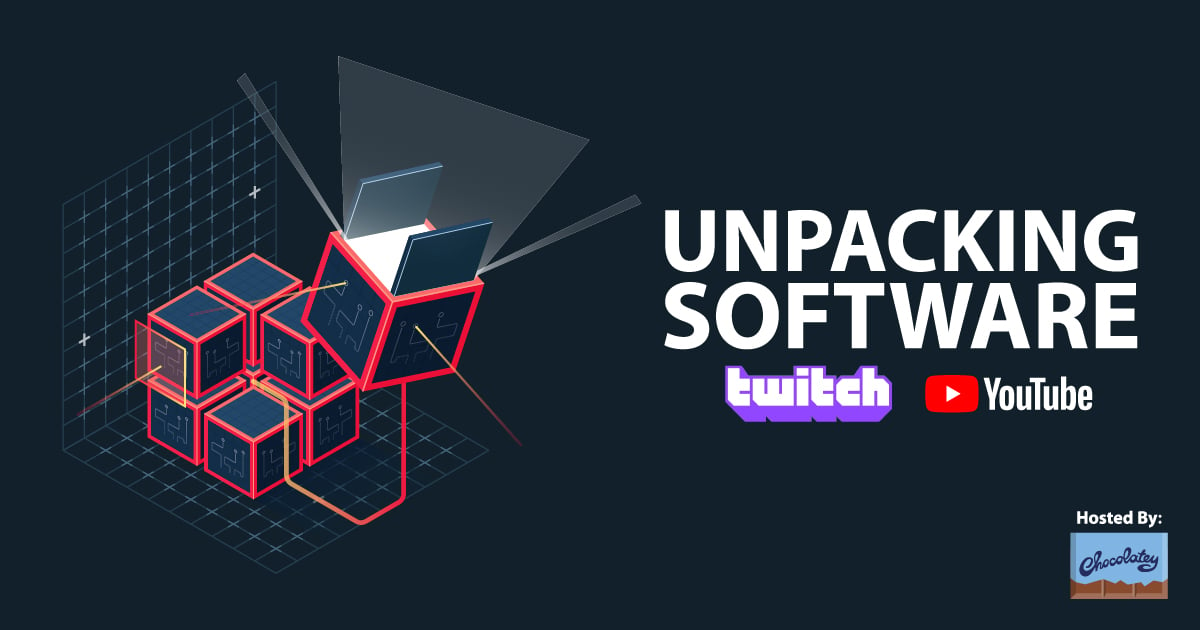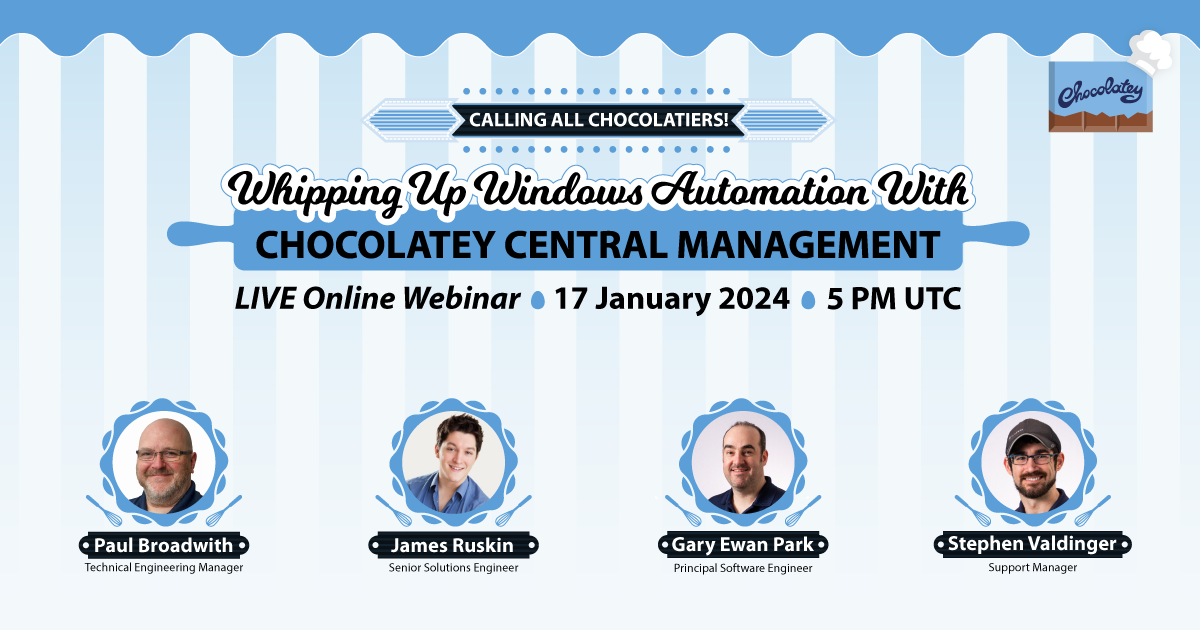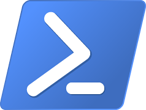
Downloads:
3,340
Downloads of v 1.0.0:
3,199
Last Update:
28 Jan 2016
Package Maintainer(s):
Software Author(s):
- Rob Reynolds
- The Chocolatey Team
Tags:
- Software Specific:
- Software Site
- Software License
- Package Specific:
- Package outdated?
- Package broken?
- Contact Maintainers
- Contact Site Admins
- Software Vendor?
- Report Abuse
- Download
Chocolatey Default Template
- 1
- 2
- 3
1.0.0 | Updated: 28 Jan 2016
- Software Specific:
- Software Site
- Software License
- Package Specific:
- Package outdated?
- Package broken?
- Contact Maintainers
- Contact Site Admins
- Software Vendor?
- Report Abuse
- Download
Downloads:
3,340
Downloads of v 1.0.0:
3,199
Maintainer(s):
Software Author(s):
- Rob Reynolds
- The Chocolatey Team
Chocolatey Default Template 1.0.0
Legal Disclaimer: Neither this package nor Chocolatey Software, Inc. are affiliated with or endorsed by Rob Reynolds, The Chocolatey Team. The inclusion of Rob Reynolds, The Chocolatey Team trademark(s), if any, upon this webpage is solely to identify Rob Reynolds, The Chocolatey Team goods or services and not for commercial purposes.
- 1
- 2
- 3
All Checks are Passing
3 Passing Tests
Deployment Method: Individual Install, Upgrade, & Uninstall
To install Chocolatey Default Template, run the following command from the command line or from PowerShell:
To upgrade Chocolatey Default Template, run the following command from the command line or from PowerShell:
To uninstall Chocolatey Default Template, run the following command from the command line or from PowerShell:
Deployment Method:
This applies to both open source and commercial editions of Chocolatey.
1. Enter Your Internal Repository Url
(this should look similar to https://community.chocolatey.org/api/v2/)
2. Setup Your Environment
1. Ensure you are set for organizational deployment
Please see the organizational deployment guide
2. Get the package into your environment
Option 1: Cached Package (Unreliable, Requires Internet - Same As Community)-
Open Source or Commercial:
- Proxy Repository - Create a proxy nuget repository on Nexus, Artifactory Pro, or a proxy Chocolatey repository on ProGet. Point your upstream to https://community.chocolatey.org/api/v2/. Packages cache on first access automatically. Make sure your choco clients are using your proxy repository as a source and NOT the default community repository. See source command for more information.
- You can also just download the package and push it to a repository Download
-
Open Source
-
Download the package:
Download - Follow manual internalization instructions
-
-
Package Internalizer (C4B)
-
Run: (additional options)
choco download default.template --internalize --source=https://community.chocolatey.org/api/v2/ -
For package and dependencies run:
choco push --source="'INTERNAL REPO URL'" - Automate package internalization
-
Run: (additional options)
3. Copy Your Script
choco upgrade default.template -y --source="'INTERNAL REPO URL'" [other options]See options you can pass to upgrade.
See best practices for scripting.
Add this to a PowerShell script or use a Batch script with tools and in places where you are calling directly to Chocolatey. If you are integrating, keep in mind enhanced exit codes.
If you do use a PowerShell script, use the following to ensure bad exit codes are shown as failures:
choco upgrade default.template -y --source="'INTERNAL REPO URL'"
$exitCode = $LASTEXITCODE
Write-Verbose "Exit code was $exitCode"
$validExitCodes = @(0, 1605, 1614, 1641, 3010)
if ($validExitCodes -contains $exitCode) {
Exit 0
}
Exit $exitCode
- name: Install default.template
win_chocolatey:
name: default.template
version: '1.0.0'
source: INTERNAL REPO URL
state: present
See docs at https://docs.ansible.com/ansible/latest/modules/win_chocolatey_module.html.
chocolatey_package 'default.template' do
action :install
source 'INTERNAL REPO URL'
version '1.0.0'
end
See docs at https://docs.chef.io/resource_chocolatey_package.html.
cChocoPackageInstaller default.template
{
Name = "default.template"
Version = "1.0.0"
Source = "INTERNAL REPO URL"
}
Requires cChoco DSC Resource. See docs at https://github.com/chocolatey/cChoco.
package { 'default.template':
ensure => '1.0.0',
provider => 'chocolatey',
source => 'INTERNAL REPO URL',
}
Requires Puppet Chocolatey Provider module. See docs at https://forge.puppet.com/puppetlabs/chocolatey.
4. If applicable - Chocolatey configuration/installation
See infrastructure management matrix for Chocolatey configuration elements and examples.
This package was approved by moderator gep13 on 28 Jan 2016.
Chocolatey Default Template
This replaces the default Chocolatey template with the current fixes for the template.
<?xml version="1.0" encoding="utf-8"?>
<!-- Read this before creating packages: https://github.com/chocolatey/chocolatey/wiki/CreatePackages -->
<!-- It is especially important to read the above link to understand additional requirements when publishing packages to the community feed aka dot org (https://chocolatey.org/packages). -->
<!-- Test your packages in a test environment: https://github.com/chocolatey/chocolatey-test-environment -->
<!--
This is a nuspec. It mostly adheres to https://docs.nuget.org/create/Nuspec-Reference. Chocolatey uses a special version of NuGet.Core that allows us to do more than was initially possible. As such there are certain things to be aware of:
* the package xmlns schema url may cause issues with nuget.exe
* Any of the following elements can ONLY be used by choco tools - projectSourceUrl, docsUrl, mailingListUrl, bugTrackerUrl, packageSourceUrl, provides, conflicts, replaces
* nuget.exe can still install packages with those elements but they are ignored. Any authoring tools or commands will error on those elements
-->
<!-- You can embed software files directly into packages, as long as you are not bound by distribution rights. -->
<!-- * If you are an organization making private packages, you probably have no issues here -->
<!-- * If you are releasing to the community feed, you need to consider distribution rights. -->
<!-- Do not remove this test for UTF-8: if “Ω” doesn’t appear as greek uppercase omega letter enclosed in quotation marks, you should use an editor that supports UTF-8, not this one. -->
<package xmlns="http://schemas.microsoft.com/packaging/2015/06/nuspec.xsd">
<metadata>
<!-- == PACKAGE SPECIFIC SECTION == -->
<!-- This section is about this package, although id and version have ties back to the software -->
<!-- id is lowercase and if you want a good separator for words, use '-', not '.'. Dots are only acceptable as suffixes for certain types of packages, e.g. .install, .portable, .extension, .template -->
<!-- If the software is cross-platform, attempt to use the same id as the debian/rpm package(s) if possible. -->
<id>[[PackageNameLower]]</id>
<!-- version should MATCH as closely as possible with the underlying software -->
<!-- Is the version a prerelease of a version? https://docs.nuget.org/create/versioning#creating-prerelease-packages -->
<!-- Note that unstable versions like 0.0.1 can be considered a released version, but it's possible that one can release a 0.0.1-beta before you release a 0.0.1 version. If the version number is final, that is considered a released version and not a prerelease. -->
<version>[[PackageVersion]]</version>
<!-- <packageSourceUrl>Where is this Chocolatey package located (think GitHub)? packageSourceUrl is highly recommended for the community feed</packageSourceUrl>-->
<!-- owners is a poor name for maintainers of the package. It sticks around by this name for compatibility reasons. It basically means you. -->
<!--<owners>[[MaintainerName]]</owners>-->
<!-- ============================== -->
<!-- == SOFTWARE SPECIFIC SECTION == -->
<!-- This section is about the software itself -->
<title>[[PackageName]] (Install)</title>
<authors>__REPLACE_AUTHORS_OF_SOFTWARE_COMMA_SEPARATED__</authors>
<!-- projectUrl is required for the community feed -->
<projectUrl>https://_Software_Location_REMOVE_OR_FILL_OUT_</projectUrl>
<!--<iconUrl>http://cdn.rawgit.com/[[MaintainerRepo]]/master/icons/[[PackageNameLower]].png</iconUrl>-->
<!-- <copyright>Year Software Vendor</copyright> -->
<!-- If there is a license Url available, it is is required for the community feed -->
<!-- <licenseUrl>Software License Location __REMOVE_OR_FILL_OUT__</licenseUrl>
<requireLicenseAcceptance>true</requireLicenseAcceptance>-->
<!--<projectSourceUrl>Software Source Location - is the software FOSS somewhere? Link to it with this</projectSourceUrl>-->
<!--<docsUrl>At what url are the software docs located?</docsUrl>-->
<!--<mailingListUrl></mailingListUrl>-->
<!--<bugTrackerUrl></bugTrackerUrl>-->
<summary>__REPLACE__</summary>
<tags>[[PackageNameLower]] admin SPACE_SEPARATED</tags>
<description>__REPLACE__MarkDown_Okay [[AutomaticPackageNotesNuspec]]</description>
<!-- <releaseNotes>__REPLACE_OR_REMOVE__MarkDown_Okay</releaseNotes> -->
<!-- =============================== -->
<!-- Specifying dependencies and version ranges? https://docs.nuget.org/create/versioning#specifying-version-ranges-in-.nuspec-files -->
<!--<dependencies>
<dependency id="" version="__MINIMUM_VERSION__" />
<dependency id="" version="[__EXACT_VERSION__]" />
<dependency id="" version="[_MIN_VERSION_INCLUSIVE, MAX_VERSION_INCLUSIVE]" />
<dependency id="" version="[_MIN_VERSION_INCLUSIVE, MAX_VERSION_EXCLUSIVE)" />
<dependency id="" />
</dependencies>-->
<!--<provides>NOT YET IMPLEMENTED</provides>-->
<!--<conflicts>NOT YET IMPLEMENTED</conflicts>-->
<!--<replaces>NOT YET IMPLEMENTED</replaces>-->
</metadata>
<files>
<!-- this section controls what actually gets packaged into the Chocolatey package -->
<file src="tools\**" target="tools" />
<!--Building from Linux? You may need this instead: <file src="tools/**" target="tools" />-->
</files>
</package>
## Summary
How do I create packages? See https://github.com/chocolatey/choco/wiki/CreatePackages
If you are submitting packages to the community feed (https://chocolatey.org)
always try to ensure you have read, understood and adhere to the create
packages wiki link above.
## Automatic Packages?
Consider making this package an automatic package, for the best
maintainability over time. Read up at https://github.com/chocolatey/choco/wiki/AutomaticPackages
## Shim Generation
Any executables you include in the package or download (but don't call
install against using the built-in functions) will be automatically shimmed.
This means those executables will automatically be included on the path.
Shim generation runs whether the package is self-contained or uses automation
scripts.
By default, these are considered console applications.
If the application is a GUI, you should create an empty file next to the exe
named 'name.exe.gui' e.g. 'bob.exe' would need a file named 'bob.exe.gui'.
See https://github.com/chocolatey/choco/wiki/CreatePackages#how-do-i-set-up-batch-redirects-for-applications-that-have-a-gui
If you want to ignore the executable, create an empty file next to the exe
named 'name.exe.ignore' e.g. 'bob.exe' would need a file named
'bob.exe.ignore'.
See https://github.com/chocolatey/choco/wiki/CreatePackages#how-do-i-exclude-executables-from-getting-batch-redirects
## Self-Contained?
If you have a self-contained package, you can remove the automation scripts
entirely and just include the executables, they will automatically get shimmed,
which puts them on the path. Ensure you have the legal right to distribute
the application though. See https://github.com/chocolatey/choco/wiki/Legal.
You should read up on the Shim Generation section to familiarize yourself
on what to do with GUI applications and/or ignoring shims.
## Automation Scripts
You have a powerful use of Chocolatey, as you are using PowerShell. So you
can do just about anything you need. Choco has some very handy built-in
functions that you can use, these are sometimes called the helpers.
### Built-In Functions
https://github.com/chocolatey/choco/wiki/HelpersReference
A note about a couple:
* Get-BinRoot - this is a horribly named function that doesn't do what new folks think it does. It gets you the 'tools' root, which by default is set to 'c:\tools', not the chocolateyInstall bin folder.
* Install-BinFile - used for non-exe files - executables are automatically shimmed...
* Uninstall-BinFile - used for non-exe files - executables are automatically shimmed
### Getting package specific information
Use the package parameters pattern - see https://github.com/chocolatey/choco/wiki/How-To-Parse-PackageParameters-Argument
### Need to mount an ISO?
https://github.com/chocolatey/choco/wiki/How-To-Mount-An-Iso-In-Chocolatey-Package
### Environment Variables
Chocolatey makes a number of environment variables available (You can access any of these with $env:TheVariableNameBelow):
* TEMP = Overridden to the CacheLocation, but may be the same as the original TEMP folder
* ChocolateyInstall = Top level folder where Chocolatey is installed
* chocolateyPackageName = The name of the package, equivalent to the id in the nuspec (0.9.9+)
* chocolateyPackageVersion = The version of the package, equivalent to the version in the nuspec (0.9.9+)
* chocolateyPackageFolder = The top level location of the package folder
#### Advanced Environment Variables
The following are more advanced settings:
* chocolateyPackageParameters = (0.9.8.22+)
* CHOCOLATEY_VERSION = The version of Choco you normally see. Use if you are 'lighting' things up based on choco version. (0.9.9+)
- Otherwise take a dependency on the specific version you need.
* chocolateyForceX86 = If available and set to 'true', then user has requested 32bit version. (0.9.9+)
- Automatically handled in built in Choco functions.
* OS_PLATFORM = Like Windows, OSX, Linux. (0.9.9+)
* OS_VERSION = The version of OS, like 6.1 something something for Windows. (0.9.9+)
* OS_NAME = The reported name of the OS. (0.9.9+)
* IS_PROCESSELEVATED = Is the process elevated? (0.9.9+)
#### Experimental Environment Variables
The following are experimental or use not recommended:
* OS_IS64BIT = This may not return correctly - it may depend on the process the app is running under (0.9.9+)
* CHOCOLATEY_VERSION_PRODUCT = the version of Choco that may match CHOCOLATEY_VERSION but may be different (0.9.9+)
- it's based on git describe
* IS_ADMIN = Is the user an administrator? But doesn't tell you if the process is elevated. (0.9.9+)
* chocolateyInstallOverride = Not for use in package automation scripts. (0.9.9+)
* chocolateyInstallArguments = the installer arguments meant for the native installer. You should use chocolateyPackageParameters intead. (0.9.9+)
# IMPORTANT: Before releasing this package, copy/paste the next 2 lines into PowerShell to remove all comments from this file:
# $f='c:\path\to\thisFile.ps1'
# gc $f | ? {$_ -notmatch "^\s*#"} | % {$_ -replace '(^.*?)\s*?[^``]#.*','$1'} | Out-File $f+".~" -en utf8; mv -fo $f+".~" $f
# If this is an MSI, cleaning up comments is all you need.
# If this is an exe, change installerType and silentArgs
# Auto Uninstaller should be able to detect and handle registry uninstalls (if it is turned on, it is in preview for 0.9.9).
$ErrorActionPreference = 'Stop'; # stop on all errors
$packageName = '[[PackageName]]'
$softwareName = '[[PackageName]]*' #part or all of the Display Name as you see it in Programs and Features. It should be enough to be unique
$installerType = 'MSI'
#$installerType = 'EXE'
$silentArgs = '/qn /norestart'
# https://msdn.microsoft.com/en-us/library/aa376931(v=vs.85).aspx
$validExitCodes = @(0, 3010, 1605, 1614, 1641)
if ($installerType -ne 'MSI') {
# The below is somewhat naive and built for EXE installers
# Uncomment matching EXE type (sorted by most to least common)
#$silentArgs = '/S' # NSIS
#$silentArgs = '/VERYSILENT /SUPPRESSMSGBOXES /NORESTART /SP-' # Inno Setup
#$silentArgs = '/s' # InstallShield
#$silentArgs = '/s /v"/qn"' # InstallShield with MSI
#$silentArgs = '/s' # Wise InstallMaster
#$silentArgs = '-s' # Squirrel
#$silentArgs = '-q' # Install4j
#$silentArgs = '-s -u' # Ghost
# Note that some installers, in addition to the silentArgs above, may also need assistance of AHK to achieve silence.
#$silentArgs = '' # none; make silent with input macro script like AutoHotKey (AHK)
# https://chocolatey.org/packages/autohotkey.portable
$validExitCodes = @(0)
}
$uninstalled = $false
$local_key = 'HKCU:\Software\Microsoft\Windows\CurrentVersion\Uninstall\*'
$machine_key = 'HKLM:\SOFTWARE\Microsoft\Windows\CurrentVersion\Uninstall\*'
$machine_key6432 = 'HKLM:\SOFTWARE\Wow6432Node\Microsoft\Windows\CurrentVersion\Uninstall\*'
$key = Get-ItemProperty -Path @($machine_key6432,$machine_key, $local_key) `
-ErrorAction SilentlyContinue `
| ? { $_.DisplayName -like "$softwareName" }
if ($key.Count -eq 1) {
$key | % {
$file = "$($_.UninstallString)"
if ($installerType -eq 'MSI') {
# The Product Code GUID is all that should be passed for MSI, and very
# FIRST, because it comes directly after /x, which is already set in the
# Uninstall-ChocolateyPackage msiargs (facepalm).
$silentArgs = "$($_.PSChildName) $silentArgs"
# Don't pass anything for file, it is ignored for msi (facepalm number 2)
# Alternatively if you need to pass a path to an msi, determine that and
# use it instead of the above in silentArgs, still very first
$file = ''
}
Uninstall-ChocolateyPackage -PackageName $packageName `
-FileType $installerType `
-SilentArgs "$silentArgs" `
-ValidExitCodes $validExitCodes `
-File "$file"
}
} elseif ($key.Count -eq 0) {
Write-Warning "$packageName has already been uninstalled by other means."
} elseif ($key.Count -gt 1) {
Write-Warning "$key.Count matches found!"
Write-Warning "To prevent accidental data loss, no programs will be uninstalled."
Write-Warning "Please alert package maintainer the following keys were matched:"
$key | % {Write-Warning "- $_.DisplayName"}
}
## OTHER HELPERS
## https://github.com/chocolatey/choco/wiki/HelpersReference
#Uninstall-ChocolateyZipPackage $packageName
#Uninstall-BinFile # Only needed if you added one in the installer script, choco will remove the ones it added automatically.
#remove any shortcuts you added
Log in or click on link to see number of positives.
In cases where actual malware is found, the packages are subject to removal. Software sometimes has false positives. Moderators do not necessarily validate the safety of the underlying software, only that a package retrieves software from the official distribution point and/or validate embedded software against official distribution point (where distribution rights allow redistribution).
Chocolatey Pro provides runtime protection from possible malware.
RealDimensions Software, LLC - 2016-Present
This package has no dependencies.
Ground Rules:
- This discussion is only about Chocolatey Default Template and the Chocolatey Default Template package. If you have feedback for Chocolatey, please contact the Google Group.
- This discussion will carry over multiple versions. If you have a comment about a particular version, please note that in your comments.
- The maintainers of this Chocolatey Package will be notified about new comments that are posted to this Disqus thread, however, it is NOT a guarantee that you will get a response. If you do not hear back from the maintainers after posting a message below, please follow up by using the link on the left side of this page or follow this link to contact maintainers. If you still hear nothing back, please follow the package triage process.
- Tell us what you love about the package or Chocolatey Default Template, or tell us what needs improvement.
- Share your experiences with the package, or extra configuration or gotchas that you've found.
- If you use a url, the comment will be flagged for moderation until you've been whitelisted. Disqus moderated comments are approved on a weekly schedule if not sooner. It could take between 1-5 days for your comment to show up.









 Ansible
Ansible

 PS DSC
PS DSC

